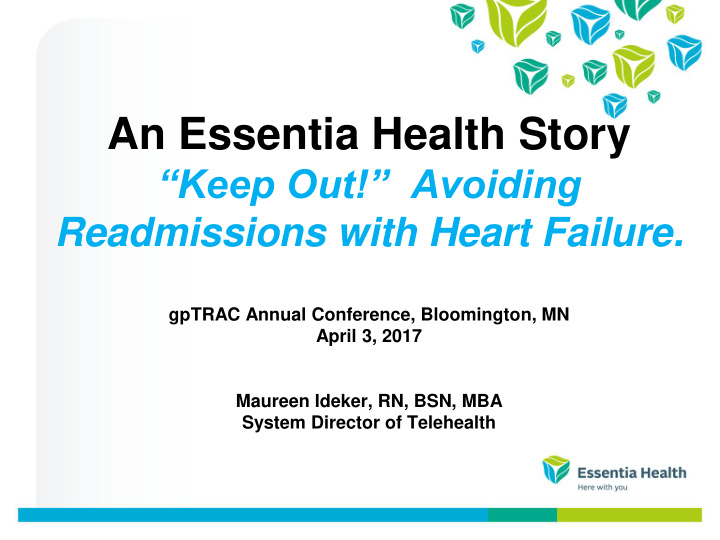



An Essentia Health Story “Keep Out!” Avoiding Readmissions with Heart Failure. gpTRAC Annual Conference, Bloomington, MN April 3, 2017 Maureen Ideker, RN, BSN, MBA System Director of Telehealth
Essentia Health as an ACO One of six health care systems in Country to achieve: NCQA Accreditation as an Accountable Care Organization Definition A provider-based organization that take responsibility for meeting the health care needs of a defined population with the goal of simultaneously improving health, improving patient experience and reducing per capita costs. (Triple Aim)
Why Heart Failure? Prevalence – Affects 5.8 million in the U.S. – Over 650,000 new patients annually – The lifetime risk of developing HF is 20% for Americans ≥40 years of age. – HF is the most frequent cause of hospitalization in elderly (> 65 y/o) Prognosis – 1/2 of people who develop HF die within 5 years of their diagnosis – Less than 25% are alive at 10 years
Heart Failure Progression is Inevitable • HF is not always treated correctly • Patients do not adhere to diet and medication regime • Projections show the prevalence of HF will increase 46% from 2012 to 2030, resulting in >8 million people ≥18 years of age with HF AHA Heart Disease & Stroke Statistics 2014 Update
What will it Cost? • Estimated lifetime cost per each individual HF patient is $110,000/year • In 2012, total cost for HF was estimated to be $30.7 million • Projections show that by 2030, the total cost of HF will increase almost 127% to $69.7 billion from 2012
Summary % Readmissions for Heart Failure Within 30 Days • National – 24% • Essentia Health – Duluth – 9% • Essentia Health with Tele-Home Monitoring Scales – 2%
Essentia’ s Tele -Home Monitoring Results Support Findings from Original Research • Kaiser – Permanente (2000) • University of Minnesota (2006) • (References attached)
Essentia’s HF Program Model • Consult 5-7 days after hospital discharge • Patients managed by APP in ambulatory setting • Seen by cardiologist initially, annually and as needed • Registered nurses provide continuous case management: – Phone triage – Follow-up on labs/ test results – Utilize protocols – Manage telescale data – ONGOING PATIENT EDUCATION
Monitoring and Exception Review • Patient alerts in Cardiocom – Nurse reviews data in both Cardiocom and EPIC – Makes decision if patient needs to be contacted • If assessment is needed the nurse considers the following: – Nursing assessment and education needs – Review medication list – Dietary compliance – Follows diuretic protocol as indicated/or talks with provider – Initiate office visits or primary care referrals as needed – Care plan monitoring; hospitalization initiation – Communication with team members (other specialties)
HF Program Outcomes Data: 12 Months East HF Program Patients 1,952 East HF Programs Pts. 2,288 (Inpt. & Outpt.) 2016 (Inpts. & Outpts.) 2014 HF Admissions (185) Initial Diag. 9.5% Tele-Home Monitored 13% Pts. (296) All Cause 30 Day Readmissions 9.25 (17) HF Tele-Home Pts. – 0% 30 Day Readmissions (0) HF 30 Day Readmissions (6) 3.2% HF 365 Day Tele-Home 2% Pts. Readmissions (6)
Appropriate use of telescales Consider for: Not recommended for: • • Patients with 2 or more Dialysis patients hospitalizations for HF during the past year • Weight loss program • Patients unable to self-report • Patients residing in skilled nursing weights within given parameters facility with 24 hour care and/or inadequate social support • Unsteady patients • Patients who live great distances from clinic and have difficulty getting to office visits
Advantages to Tele-monitoring • Facilitates early intervention and prevents ER visits and hospitalizations • Improved patient adherence with care plan • Patients get immediate feedback on life style choices • High patient satisfaction • Family reassured • Provides additional opportunity to educate patients • Builds trust between patient and provider
HF Program THEN NOW ACO model Fee for Service Model • Greatly improves the quality of • Expense Center care for HF patients • Little if any payment for • Reduces the cost of medical services care by reducing admissions, readmissions and ED visits • Reimbursement reducer • Improved service and experience for patients with • Prevents admissions, close monitoring and readmissions and ED visits coordination of care • ACOs rewarded for improving quality of care and controlling costs.
Re Refer erences ences • American Hospital Association. Telehealth: Helping Hospitals Deliver Cost-Effective Care, pgs1-7, 4/22/16. www.aha.org • Erickson C, Ideker M, Fauchald S. Integrating Telehealth Into the Graduate Nursing Curriculum. The Journal for Nurse Practitioners 2015; e1-5. • Finkelstein S, Speedie S, Potthoff, . Home telehealth Improves Clinical Outcomes at Lower Cost for Home Healthcare. Telemedicine and e-Health Vol 12, N0 2, 2006: 128-136. • Johns Hopkins Medicine. A Typical Hospital at Home Program Follows these Steps. http://www.hospitalathome.org/about-us/how-it-works.php. • Johnston B, Wheeler L, Deuser J, Sousa KH. Outcomes of the Kaiser-Permanente Tele-Home health research project. Arch Fam Med 2000;9:40-45.
Thank you!! Questions?? Maureen Ideker, RN BSN MBA System Director of Telehealth Maureen.Ideker@essentiahealth.org
Recommend
More recommend